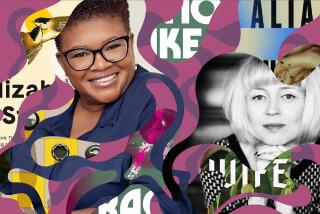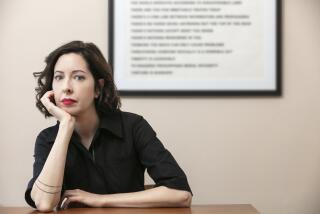That Obscure Object of Desire
- Share via
I’ve been trying to recall my exact response 10 years ago to the news that a long-married friend with grown children had had several lesbian affairs--largely stemming from her involvement in feminist activism--one so consuming she and her husband briefly discussed living in a menage a trois with the other woman. I think I was puzzled and surprised. The pieces didn’t seem to fit. Loving couple and lesbian affairs? Sex and politics? It was the first time I was confronted with issues of gender and sexuality that couldn’t be labeled and placed neatly in the appropriate box.
Since then I’ve seen desire take others along similar indeterminate routes. There’s the gay man who’s sometimes attracted to strong women; the woman who says she’s a lesbian “emotionally” but who has occasional flings with men; seemingly heterosexual men who find they are gay; women who’ve had lesbian experiences but settled down with men; and, most common of all, women who’ve lived as heteros but discover same-sex love at mid-life--”lesbians-come-lately,” as one lesbian publication once sneeringly put it. At a certain point, I stopped agonizing. As long as they are not part of some unequal power arrangement, most manifestations of the erotic now seem to be simply another thread in life’s rich tapestry.
That’s not to say I came to this all-accepting attitude alone. In the 10 years since my friend came out to me, times have changed. Gay rights battles (some successful, some promoting right-wing backlash), lesbian chic, gay organizations’ acceptance of transgendered persons and bisexuals have brought sexual orientation before the public’s gaze and nudged us into a recognition of desire as a bit more complicated than we once thought. Even the heterosexual realm has contributed to the general mind shift; the Clinton soap opera and related subplots have proven not only that adultery is a common occurrence but also that any heightened situation can be a catalyst for desire.
Of course, people have always committed adultery (see the Bible), always bounced back and forth between genders (see ancient Greece), always located the roots of sexual passion in the imagination. But perhaps our time is different in that we are openly discussing these matters and working hard to incorporate them into--and not merely keep them submerged beneath--the mainstream. Closets of all kinds are bursting open, most notably the closet of oversimplification.
Which makes this an extraordinarily appropriate moment for the publication of “Apples & Oranges,” a memoir by Jan Clausen, a self-described “hasbian” and “floating woman.” After a dozen years of living with a woman with whom she was raising a daughter, Clausen fell in love with a man, a West Indian lawyer she met on a political organizing trip to Nicaragua. Her life took a 180-degree turn that was, she says, “like deliberately embarking on a sea cruise off the edge of a flat earth.”
Perhaps a less politically aware woman would have had an easier time of it. But Clausen’s world was centered on lesbian-feminist politics. She had achieved some small status as a writer on lesbian topics and lived in a tight community of lesbians who saw their relationships as an act of defiance--”our union was never just about us, but about women together defying patriarchy.” The aftershocks stemming from her “betrayal” (as some saw it) were off the scale, featuring, Clausen says, “rites of outrage” that always “serve a collective purpose, helping to affirm group membership and delineating the boundaries of acceptable behavior.”
I still have a copy of the winter 1990 issue of the now-defunct OUT/LOOK, a national gay and lesbian magazine, containing Clausen’s article “My Interesting Condition,” from which this book grew, and a couple of subsequent issues filled with readers’ letters, some supportive, many furious. Clausen was “a danger to the lesbian community far greater than any threat by homophobes,” “dishonest, irresponsible” and “subversive.” Two close friends, a lesbian couple, abruptly cut her off and haven’t talked to her since. She was “dropped from the official roster of ‘approved’ lesbian writers,” her books yanked off women’s studies syllabi countrywide. “Branded with a scarlet ‘H’ for ‘het,’ ” Clausen writes, “I’d henceforth be denounced as a lapsed woman lover, pitied as a tragic mulatto of sex.”
Still, out of her embattled, disoriented state, Clausen has fashioned a wonderful meditation on the nature of desire based on her own sexual history. Why did she sleep with boys in her teens? What brought her to “dykedom” in her 20s and to heterosexuality in her 40s? Why is it that so many of her lovers were damaged or depressed people she felt drawn to help? How did her youthful rebellion (after an apparently irreproachably happy childhood in Oregon and Northern California), her subsequent involvement in feminist and liberal politics and the lesbian literary life in New York, her ambivalence about “people in groups,” her writerly tendency to see shades of gray in everything--how did all of that play a role in shaping her understanding of sex?
Clausen asks more questions than she answers, however. From the start, she rejects biological determinism, which would locate the roots of sexual orientation in the brain’s neurological wiring, as too simple an explanation for the complexities of sexuality that “vary enormously from culture to culture”--without satisfactorily explaining the weakness of the science. And though she emphasizes the influence of social forces, especially class and race, in molding sexual identity--with a nod to Kinsey and his pioneering 1940s studies, which measured the fluidity of sexual attraction--sociological theory is not the foremost feature of this work.
Rather, she focuses on tracking “fragments” of her own life, in “mending a broken identity.” She sees herself swayed this way and that by various influences and events, nudged out of a bland childhood into a teenage rebellion exacerbated by ‘60s promiscuity. She pursued boys not entirely for sex; she identified with them (rather than with girls her own age) as the source of power, though a real sense of power came with ‘70s feminism and her relationships with women. Always the rebel, however, she later found in heterosexuality “the anarchic power of the erotic”--anarchic, that is, compared with what had become a claustrophobically cozy lesbian community life.
Clausen gives a fairly convincing picture of sexual development. Yet I’ve met too many other gays and lesbians who feel that their sexual orientation is unshakable to buy Clausen’s nurture-versus-nature attitude entirely. I’m also uneasy about her declaration that her connection with her male lover, Benjamin, could only have happened in her mature years. It smacks a little of the old mythology about lesbian relationships being juvenile.
If this sounds different from most memoirs, that’s because “Apples & Oranges” is more a treatise than a private internal journey--though with its intelligence, its good-humored, common-sense approach to life, Clausen’s story far surpasses those memoirs that drown the reader in a flood of unresolved personal angst. Clausen, a professor at the New School in New York City, was always a cerebral writer. The excitement of her best-known novel, “The Prosperine Papers,” comes not from its characterizations or language but from its reflections about women’s history prompted by the heroine’s discovery of papers and letters documenting her grandmother’s lesbian relationship.
Though there are long stretches of storytelling that come close to the texture and detail of a good novel--Clausen’s teenage adventures with a slew of depressingly awful, manipulative young men; descriptions of life with her female lover Leslie and their child Emma--”Apples & Oranges” lacks the emotional punch of the best memoirs, like Mary Karr’s “The Liar’s Club.” Where Karr paints a picture with a hundred resonances, Clausen mostly digs in the manner of an anxious academic who doesn’t want to leave one question untackled, one proof unexplored.
Clausen’s saving grace is that she is all too aware of the difficulties of her approach. Her elegant musings on how best to tell the story are one of the more appealing aspects of the book: “How to make vivid an obsolete emotion, arriving like tardy light from a fizzled star?” Even as she lingers too long over her early diaries, or too embarrassingly over the sexual implications of enemas given at an early age by her mother, the reader can’t help warming to Clausen’s repeated worries that she’s just a brainy girl obsessed with texts. Is she responding to the real world or to the world she’s read about in books? Are her early lesbian feelings genuine or simply the influence of Colette, her “nascent desires . . . merely a species of emotional plagiarism?”
One is compelled to answer: Sure. But that’s not a criticism. What Clausen does best in “Apples & Oranges” is paint a wonderful portrait of the human capacity to reinvent oneself.


